コラム
落合憲弘
John Sypal
タカザワケンジ
なぎら健壱

I wasn’t able to get to a show this past week to write about, so this week I’d like to share some thoughts on the element of Quantity in photographic exhibitions.
この1週間、コラムで紹介できる展覧会に行くことができなかったので、今日は写真展における「数量」の要素について、少し書きたいと思います。
While there is obviously impact in a concise presentation of a set of photographs, the implication that “too many” pictures is a detriment is something which many photographers in Tokyo are either unfamiliar with- or, even better- gleefully skew in practice.
膨大な量の写真を見るとき、写真集の場合は当然「インパクトがある」と感じるでしょう。それが写真展の場合はどうでしょうか。過多とも言える点数がならぶ写真展の良い例を見る機会が、東京にはたくさんあります。
Thinking back over the hundreds of exhibitions that I’ve visited in Japan, the ones which have stuck with me strongest have inevitably been not sparse, sleek shows but ones where gloriously overwhelming in both imagery and surface area.
これまで足を運んだ数百の展覧会を振り返ってみても、私の心に強く残っているのは、まばらでスマートな展覧会よりも、イメージにも面積にも圧倒されるような展覧会です。
One that immediately comes to mind is Yoshihito Muta’s unforgettable “Tokyo Hakkei” at Shinjuku’s 3rd District Gallery in 2017.
すぐに思い浮かぶのは、2017年に新宿の3rd District Galleryで行われた牟田義仁さんの忘れられない「東京八景」です。
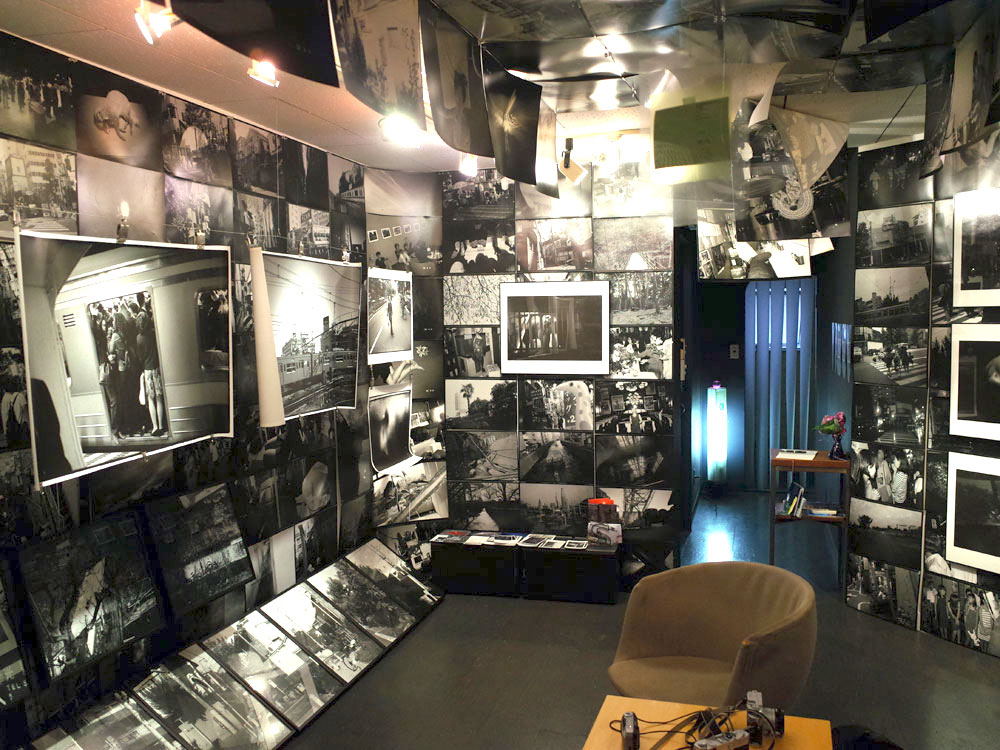
Yoshihito Muta, Tokyo Hakkei, at 3rd District Gallery in 2017
This show was of prints Muta made between 1995-2003.Awoken from their sleep, removed from their boxes, they coated nearly every surface of the gallery- certainly all of the walls, over half of the ceiling, and sometimes parts of each other. I had never seen anything like it. The show felt like (and I mean this in the best way) a lunatic’s answer to a wall-to-paper geometry problem. A calculation of time and space; Here Muta’s theory of relativity was expressed in prints. Since he had more square meters of photographs than walls, the result was a gloriously disorienting experience. Mouth ajar, I was there for over an hour and, once it was time to go, felt a pang of worry that I hadn’t seen enough. One thing was for sure- his denial of “preciousness” was liberating.
牟田義仁「東京八景」(3rd District Gallery、2017年)は、牟田さんが1995年から2003年にかけて制作した銀塩プリントでした。壁のすべて、天井の半分以上を埋め尽くすプリントは、互いが重なり合ってギャラリーを覆っていました。私は当時このような展示を見たことがありませんでした。ある幾何学的な問題に対する、写狂人の答えのように感じられました(これは最高の賛辞です!)。
時間と空間の計算。ここでは、牟田さんの相対性理論がプリントで表現されていました。壁よりも写真の面積の方が多く、口を半分開けて呆然と1時間以上滞在し、帰る時間になってまだ見足りないのではないかという不安に襲われたのを覚えています。ただひとつ確かなことは、彼は「尊さ」を否定することで解放されていたことです。

Nobuyoshi Araki, POLART 6000, at Rat Hole Gallery in 2009
Speaking of a liberatingly overwhelming show-
Nobuyoshi Araki’s POLART 6000 at Rat Hole Gallery in 2009 had (surprise!) over 6000 Polaroids on display. (I firmly believe that no other individual has taken as many Polaroids as Araki.) Incredible.
解放的で圧倒的なショーといえば、2009年にRat Hole Galleryで開催された荒木経惟「POLART 6000」では、なんと6000枚以上のポラロイドが展示されていました。荒木さんほど多くのポラロイドを撮影した人間は歴史上にいないと私は確信しています。
Thinking that he needed an “edit” to best impart particular message would be missing the point- the message, if there was one, was the experience of facing such a tsunami of palm-sized squares. Awash in a lurid sea of Polaroid- tesserae, I wonder if the impossibility of seeing everything there wasn’t sort of a metaphor for life itself.
手のひらサイズの正方形の津波を前にして、作者の意図を伝えるために「編集」が必要だと考えるのは、的外れなことかもしれません。ポラロイドという薄暗い海の中ですべてを見ることはできないという「不可能性」は、人生そのもののメタファーではないでしょうか。
Araki’s Kata-Me, an consisting of over a thousand 5x7s, as exhibited on these same Rat Hole walls in 2018.
2018年に同じRat Hole Galleryで展示されたのは、1000枚以上の5x7判で構成された荒木経惟さんの「片目」。

Nobuyoshi Araki, Kata Me, at Rat Hole Gallery in 2018
Again, with walls of images, viewers were compelled to move up and down to engage with the work. Likewise, the view of this monochromatic mandala shifted the closer or further one got. Each print was an essential part of a greater mosaic. Unlike the generally consistent experience that single row of framed photos offers, due to visitor height differences, a massive grid such as this offers a slightly different experience for each person. At 195cm tall, the show I encountered most naturally was somewhat different than what someone with a 152cm line of sight saw.
ここでも、壁一面のイメージの中で鑑賞者は上下に動いて作品と関わることを余儀なくされました。曼荼羅のように近づいたり離れたりすることで見え方が変化し、それぞれのプリントはより大きなモザイクの重要な一部でした。一列に並んだ額縁を見る一般的な体験とは異なり、この巨大なグリッドは、来場者の身長差によって、それぞれの体験は微妙に異なるでしょう。身長195cmの私と152cmの人は、この展示を見てもどこか違うのです。
The element of quantity was essential to the meaning of Meisa Fujishiro’s “90 Nights” at BOOKMARC in 2018:
2018年にBOOKMARCで行われた藤代冥砂さんの「90 Nights」の写真展は、量の要素が欠かせませんでした。
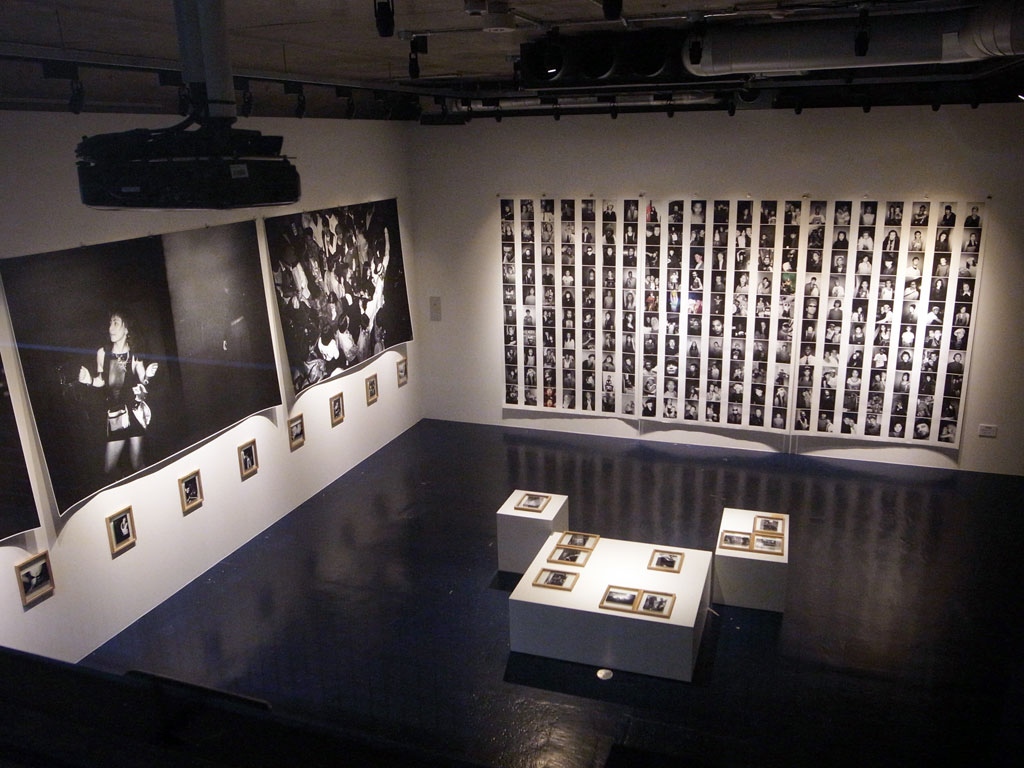
Meisa Fujishiro, 90 Nights, at BOOKMARC in 2018
In it was a magnificent grid of his fellow late-‘90s nightclubbers— through inkjet prints they looked out across two decades: over two hundred sweaty, late-night, party-flashed faces, over two hundred pairs of eyes smiled down at you in the present.
Can you imagine how different, how comparatively inadequate, a row of say, ten nicely framed of nightclub portraits would be?
展示空間には1990年代後半のナイトクラブの仲間たちの壮大なグリッドがありました。インクジェットプリントによって20年という時を超え、深夜にパーティーで汗まみれではしゃぐ200人以上の顔、200人の目が私を見下ろして笑っていました。このナイトクラブのポートレートを10枚きれいに額装して並べたら、どれほど印象が違うか、想像してみてください。
Quantity suggests life- it broadens the scope.
Getting more to see gives you more opportunity to feel.
このような数量は人生を表しているのかもしれません。鑑賞者も、より多くのものを見ることで、より多くのことを感じることができると信じてます。
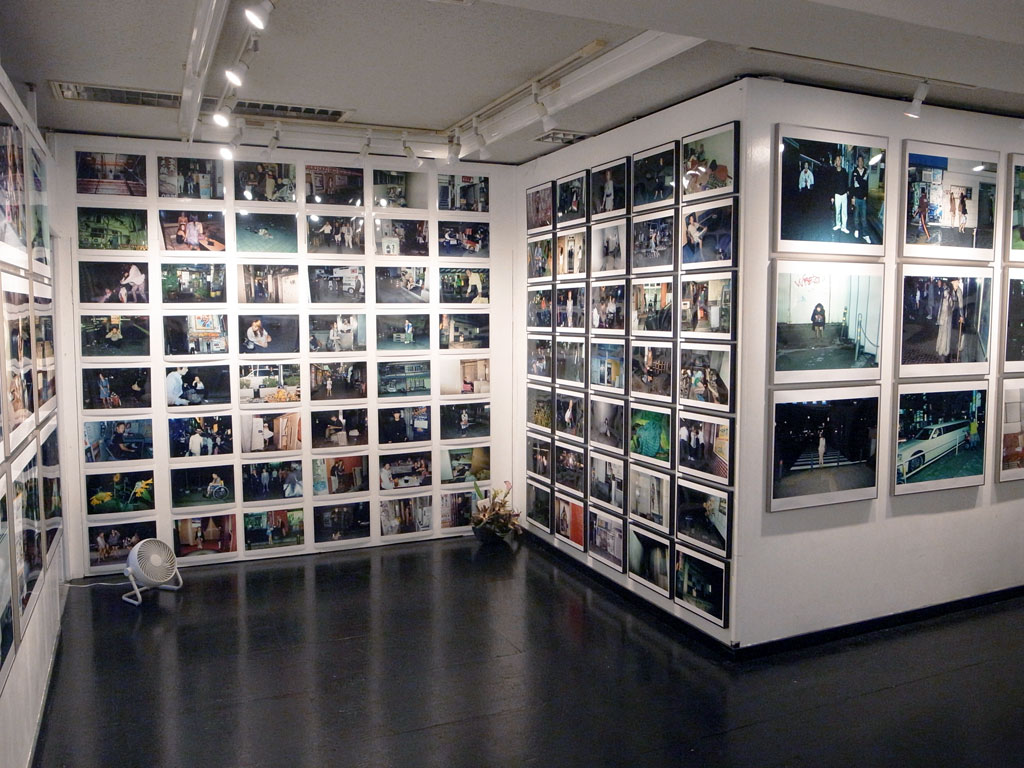
Haruto Hoshi at Place M in 2018
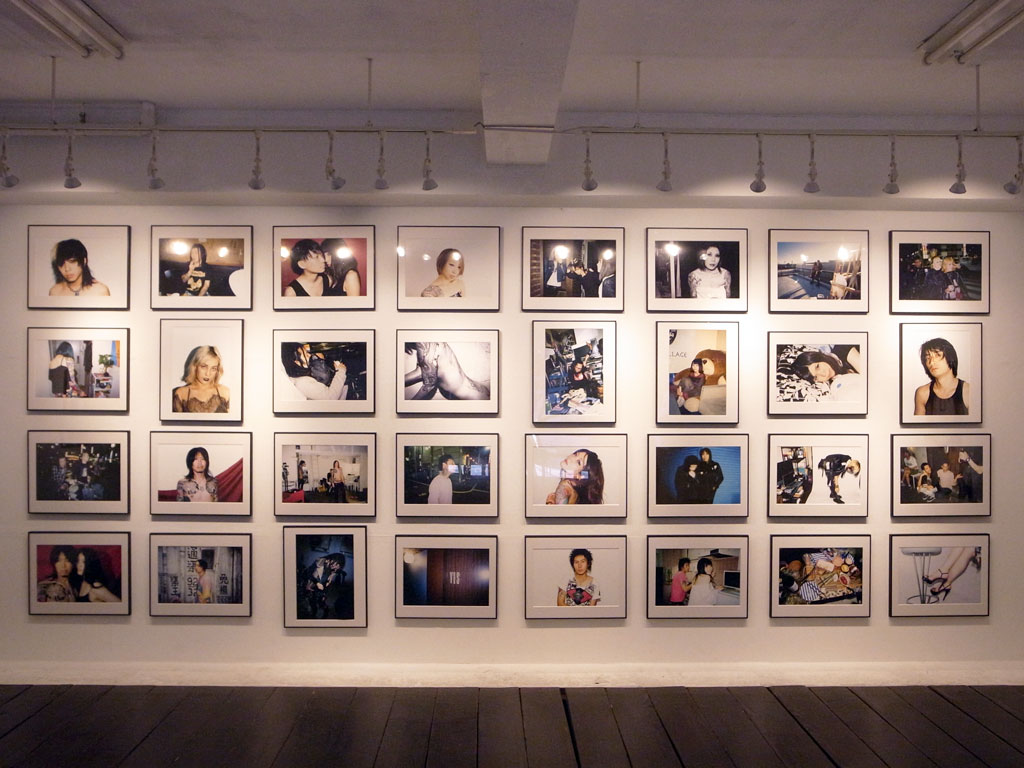
Minami Sakamoto, Wave Tossed but Unsunk, at Totem Pole Photo Gallery in 2018
I should add that one other reason I enjoy exhibitions with more pictures than “necessary” comes from my belief that every photograph possesses an innate element which surpasses the ideas and intent of their makers. More pictures, less words. Like I said, with room to look, you’ve got room to see. The other aspect is more practical. If someone (or, me) is going to make time out of their day to travel to a gallery and see some pictures, it’s best to give them enough to have make it worth the effort.
私が「写真の多い展覧会」を楽しむ理由のひとつは、写真には作り手の考えや意図を超える要素が内在していると考えているからです。写真多め、言葉少なめ。見る余地があれば、見ることができるのです。もうひとつは、より現実的な側面です。一日のうちで時間を作ってギャラリーに行って写真を見るとき、その労力に見合うだけのものを見たいと思うのは当然でしょう。
Of course, here I am talking about physical exhibitions.
Obviously- and especially with the literally endless stream of images available via our smartphone screens, the issue of “too much” can be, well, too much. There is a lot out there, more posted in a day than any one of us can ever see in our entire lifetime.
Pondering this, I think of this wonderful quote by Alec Soth:
ここでは物理的な展示について話をしてきました。スマートフォンの画面を通して、文字通り無限の画像を見ることができるようになった今、一日に投稿される画像は私たちが一生をかけても見切れないほど多すぎるのです。こういうことを考えると、写真家アレック・ソスの言葉を思い出します。
“When burdened by the feeling that there are too many photographs in the world, I ask myself if there are too many flowers.”
「世の中に写真が多すぎるという思いが重荷になるとき、花が多すぎるのではないかと自問する」
Alec Soth/アレック・ソス
He’s right. What else are you going to do about it? Photography isn’t a pyramid, but rather one large, scraggly garden. Photos bloom and weeds grow but you’re free to put as many of either in your garden (or vase) or gallery wall as you wish. I’d encourage anyone considering a photo exhibition to consider giving their audience room to look around. Quantity as an exhibition element is as critical to the experience of the work as is the content of the images.
The embrace of quantity by Japanese photographers is both a strength and hopefully, a model.
彼の言うとおりかもしれません。「写真」の世界は大きなピラミッドではなく、ひとつの大きな庭のような気がします。「写真」は咲き、ギャラリーの壁に何をどれだけ配置するかは自由です。写真展を考えている人には、鑑賞者が見回せるようなスペースを確保することをおすすめします。展示の要素としての量は、画像の内容と同様に、作品を体験する上で非常に重要です。
日本の写真家による「数量」は強みであると同時に、できれば世界の写真家のお手本になるといいな。
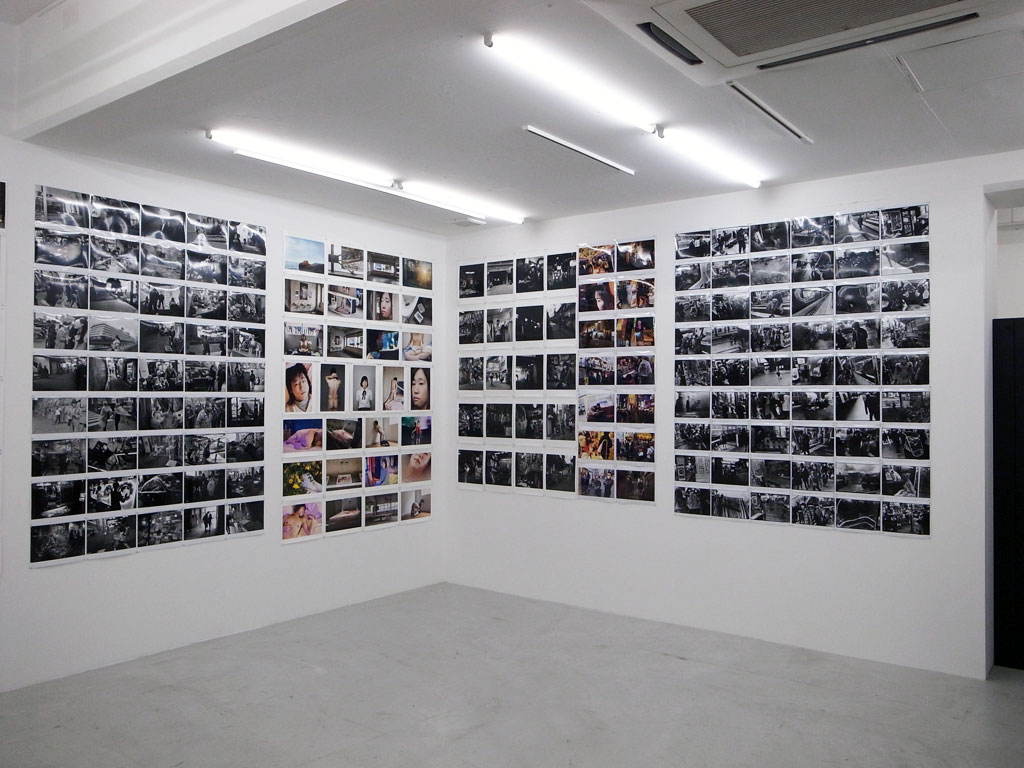
地平 Horizon group show, CASE Tokyo, 2018

Shinya Arimoto, Tokyo Circulation, Zen Foto Gallery 2016
 Vol.41 中嶋琉平|Ryuhei Nakashima「Asia, New York, and Tokyo」、高地二郎|Jiro Kochi「GINZA: Through the eye of a Salaryman 1950-1990」
2025/11/08
Vol.41 中嶋琉平|Ryuhei Nakashima「Asia, New York, and Tokyo」、高地二郎|Jiro Kochi「GINZA: Through the eye of a Salaryman 1950-1990」
2025/11/08
 Vol.40 藤岡亜弥|Aya Fujioka「Life Studies」、荒木塁|Lui Araki 「Color/Scape」
2025/10/03
Vol.40 藤岡亜弥|Aya Fujioka「Life Studies」、荒木塁|Lui Araki 「Color/Scape」
2025/10/03
 Vol.39 榎本八千代|Yachio Enomoto「家族写真 / Family Photo」
2025/09/05
Vol.39 榎本八千代|Yachio Enomoto「家族写真 / Family Photo」
2025/09/05
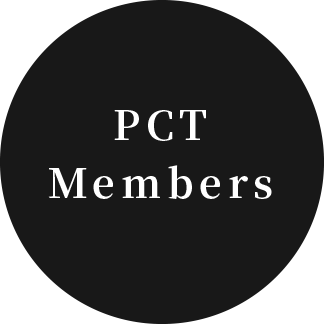
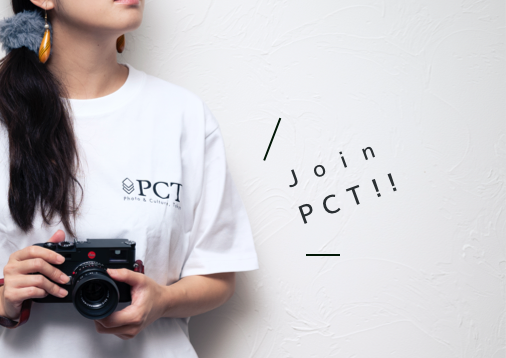
PCT Membersは、Photo & Culture, Tokyoのウェブ会員制度です。
ご登録いただくと、最新の記事更新情報・ニュースをメールマガジンでお届け、また会員限定の読者プレゼントなども実施します。
今後はさらにサービスの拡充をはかり、より魅力的でお得な内容をご提供していく予定です。
 「Photo & Culture, Tokyo」最新の更新情報や、ニュースなどをお届けメールマガジンのお届け
「Photo & Culture, Tokyo」最新の更新情報や、ニュースなどをお届けメールマガジンのお届け 書籍、写真グッズなど会員限定の読者プレゼントを実施会員限定プレゼント
書籍、写真グッズなど会員限定の読者プレゼントを実施会員限定プレゼント